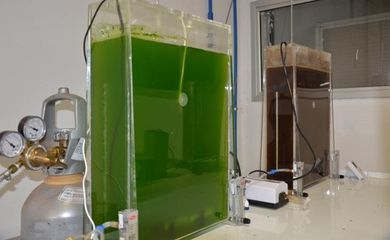Bacterial “super enzyme” can transform waste into biofuel

Researchers from the National Center for Research in Energy and Materials (CNPEM) on Thursday (Feb. 13) published in the British scientific journal Nature the process and potential of CelOCE (Cellulose Oxidative Cleaving Enzyme), a biocatalyst isolated from Brazilian soil bacteria.

The samples come from areas typically covered in sugarcane bagasse, and the analyzed bacteria were not subjected to a laboratory phase of selection or breeding. The research process spanned from bioprospecting—identifying microorganisms with potential—to producing the enzyme on an industrial scale at CNPEM's pilot plant. A patent application for the enzyme has already been filed, and it is currently being licensed for industrial use. Its adoption in the productive sector could begin within one to four years after licensing, depending on the technology used in its development.
The discovery of the bacteria was not accidental but a result of CNPEM’s genetic mapping program of microbial life within Brazil’s biodiversity. This program, conducted in collaboration with national and international partners, has previously led to the isolation of compounds with medical potential from bacteria found in a conservation unit in the Amazon. The research was carried out in partnership with the French National Research Institute for Agriculture, Food, and the Environment (INRAE, Aix-Marseille University) and the Technical University of Denmark (DTU).
This approach can also be tested under different conditions and may reveal compounds with potential applications in petrochemical and plastic recycling. It is almost like observing bacteria and replicating their solutions.
Small enzymes
CelOCE is a small enzyme, consisting of just 115 amino acids, making it easier to modify in the laboratory compared to current enzymes. This “flexibility” is one of the reasons the CNPEM team views it as a breakthrough with the potential to transform the biomass-based production chain. It can be applied in fuels, petrochemical products like plastics, organic acids, and other molecules. Industrial-scale data revealed that, when combined with enzymes already in use, CelOCE boosted the amount of glucose released from plant waste by up to 21 percent.
It works by accelerating the breakdown of cellulose through deconstruction, a necessary step in generating energy for the production of biochemicals. "This discovery shifts the paradigm of cellulose degradation in nature and has the potential to revolutionize biorefineries," explained CNPEM researcher Mario Murakami, who led the studies.
The research was driven by the goal of elucidating the metagenomic dark matter—genes of unknown function from novel microorganisms that cannot be cultivated in the laboratory. Over 90 percent of microbial life remains unexplored and may hold insights that could transform our understanding of numerous natural processes, such as cellulose degradation, as demonstrated in this study.




